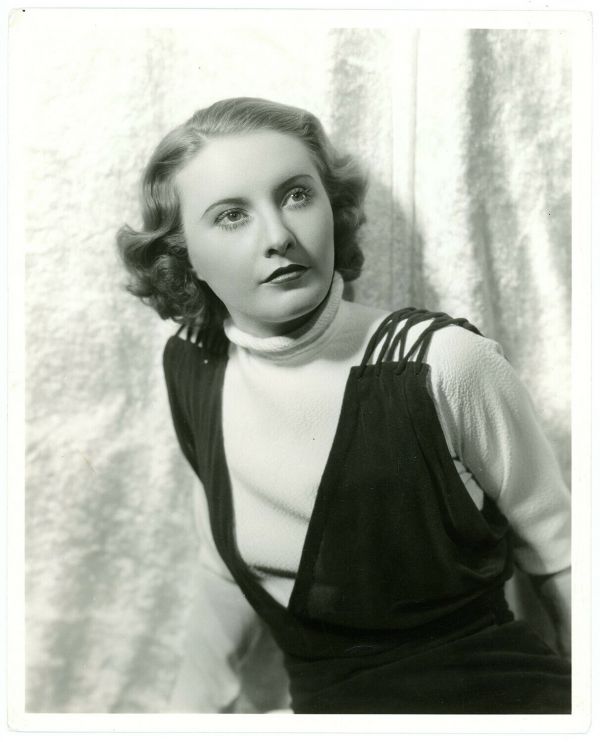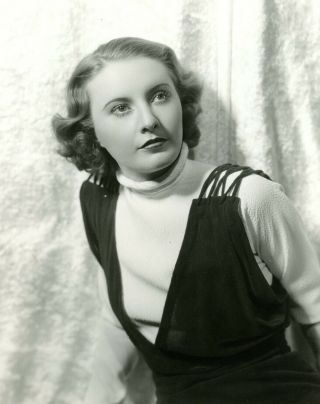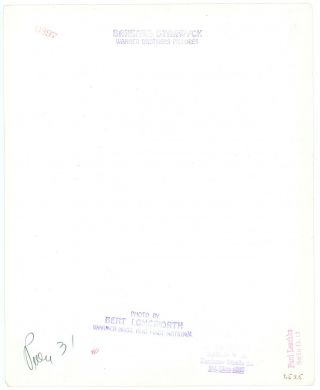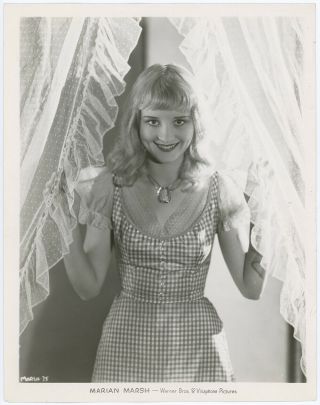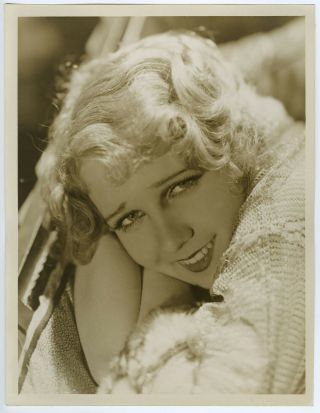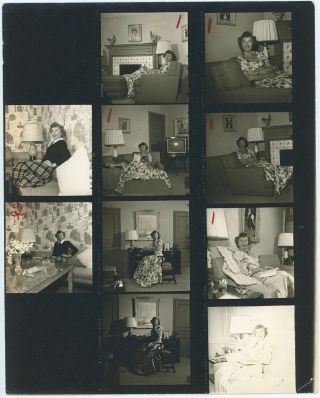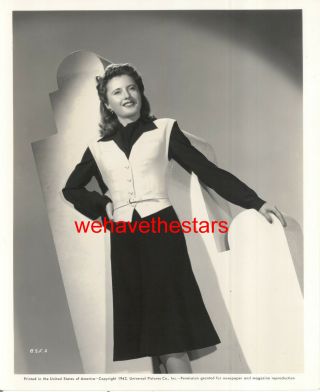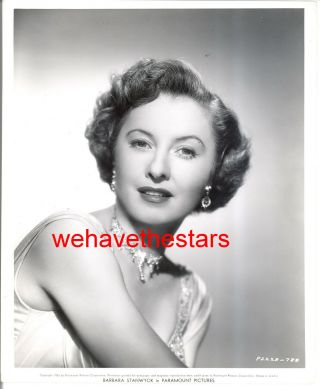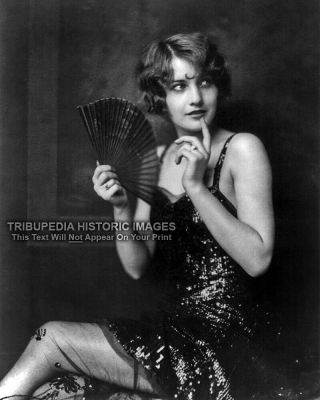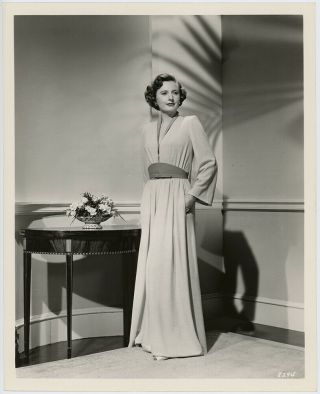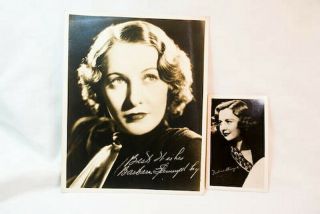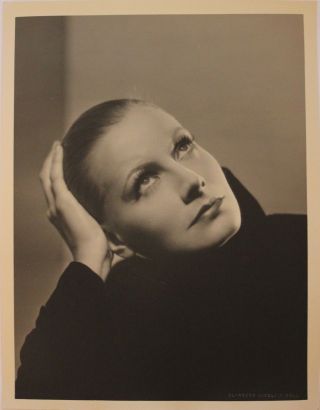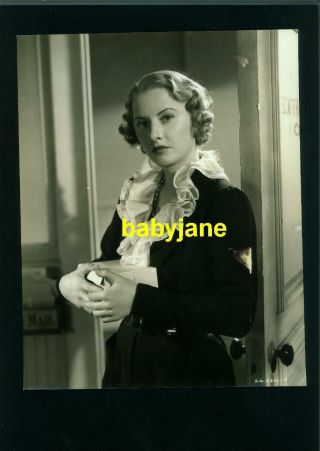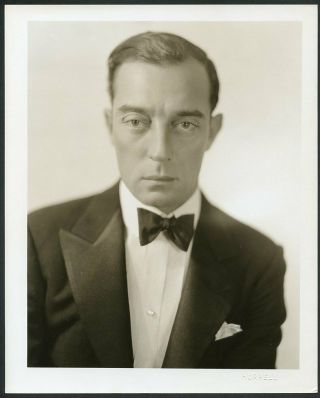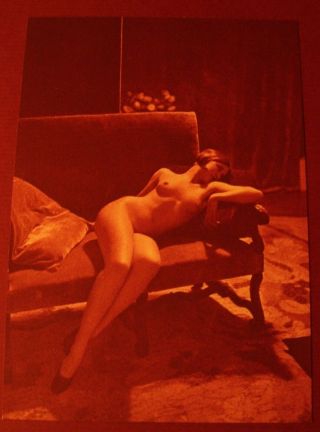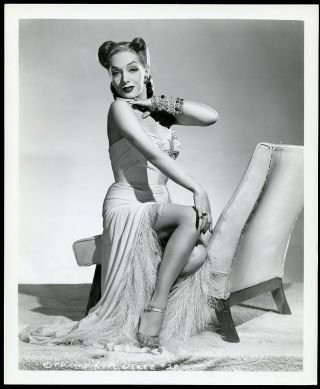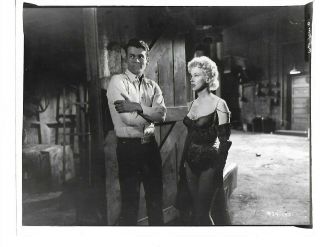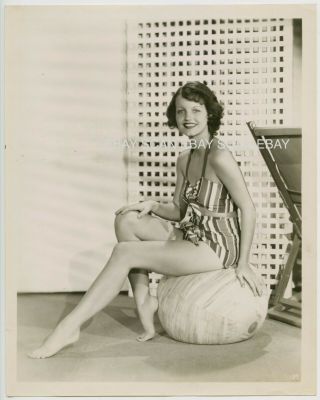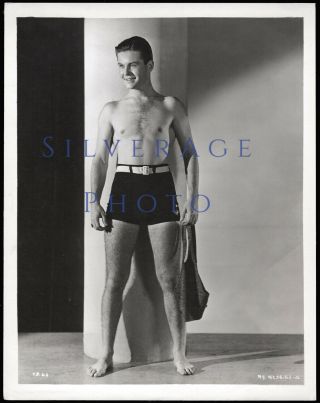Vintage 30s Barbara Stanwyck Relaxed Glamour Photograph Bert Longworth
Item History & Price
An actress, model, and dancer, Barbara Stanwyck was known during her 60-year career on stage, film, and television as a consummate and versatile professional with a strong, realistic screen presence. A favorite of directors including Cecil B. DeMille, Fritz L...ang, and Frank Capra, she made 85 films in 38 years before turning to television.
Photograph measures 8" x 10" on a glossy single weight paper stock with ink stamps and notations on verso.
Guaranteed to be 100% vintage and original from Grapefruit Moon Gallery.
More about Barbara Stanwyck:
In "The Lady Eve" Stanwyck played con artist who seduces the wealthy but unsophisticated Henry Fonda. After a misunderstanding causes them to split, she impersonates a wealthy English aristocrat to get back at him. The comedy's absurd premise remains grounded in reality, thanks to Stanwyck, who demands the audience's sympathy despite her scheming. The tiny, quirky-looking, and aggressive Stanwyck was more than a match for the tall, pretty and passive Fonda, and despite not earning an Academy Award nomination, Stanwyck's work in "The Lady Eve" ranks as perhaps her greatest comedic performance of them all."Meet John Doe" paired Stanwyck with yet another ridiculously tall, good looking leading man in Gary Cooper. They could not have been more different. Cooper was 6'3, " came from Montana, and spoke - when he spoke at all - in the quiet, flat tones of the upper Plains. Stanwyck was 5'3, " came from Brooklyn, and never lost the clipped cadences of her native New York. Director Frank Capra took full advantage of his stars' contrasts by letting their natural personalities and differences play out on screen. Stanwyck, in the role of a reporter who must scramble to save her reputation after printing a fake letter by an imagined "John Doe, " again won audience sympathy through the engaging forces of her personality and intelligence."Ball of Fire" featured Stanwyck and Cooper again, but this time in a lighter comedy than the socially pointed "Meet John Doe." Stanwyck was in her familiar element, playing another girl from the wrong side of the tracks; this time, a wisecracking nightclub singer on the lam from the mob. Cooper did a variation on the Henry Fonda role in "The Lady Eve, " lending his charm to the role of a naive professor researching American slang. Sparks fly between Stanwyck and Cooper, with each teaching the other a thing or two about their disparate worlds before falling in love. Under Howard Hawks' crisp direction, the screwball premise crackled with pitch perfect comedy and romance, leaving Stanwyck with yet another hit on her hands. She also earned her second Academy Award nomination for her work in the film.To this point, Stanwyck had proved she could play comedy, drama - even melodrama. But with "Double Indemnity" (1944), she upped the ante, proving in a platinum wig and seductive satin heels that she could play Fred MacMurray - play him for a sap, that is. One of the greatest film noir thrillers of all time, "Double Indemnity" was directed and adapted by Billy Wilder with Raymond Chandler from the James M. Cain novel. A wicked waltz danced by a scheming femme fatale and crooked insurance salesman, Stanwyck seduces MacMurray before convincing him to kill her husband to collect on his life insurance. Multiple double-crosses follow, as the couple's plan begins to unravel. Stanwyck's performance - packed with treachery, seduction and venom - earned her a third Academy Award nomination. And yet again, she was overlooked, losing out to Ingrid Bergman for "Gaslight" (1944)."Double Indemnity" represented the high-water mark of Stanwyck's cinema career. She continued acting in movies for another dozen years but none of the movies approached the searing brilliance of her earlier films. "Sorry, Wrong Number" (1948) was a fine thriller and garnered Stanwyck her final Academy Award nomination, but it did not leave an indelible mark on film culture as "Double Indemnity" did. As she aged and the movie roles became less interesting, Stanwyck turned her inestimable talents to television. "The Barbara Stanwyck Show" (NBC, 1960) lasted only one season but earned its star an Emmy Award. Stanwyck's marriage to Robert Taylor had ended in divorce in 1951, but she kept the ranch and horses they had shared. This kept her in prime riding shape to handle a host of guest appearances on Western shows like "Wagon Train" (NBC, 1957-1962; ABC, 1962-65). Finally, with the Western series "The Big Valley" (ABC, 1965-69), Stanwyck landed a long-running prime time hit that kept her busy and made her a fortune. She also won another Emmy Award for the role, playing the matriarch of a large family in central California.The aging Stanwyck's final professional triumphs were all on TV, including another Emmy Award for her work in the phenomenally successful miniseries "The Thorn Birds" (ABC, 1983) in which she played Mary Carson, the hard-as-nails owner of a ranch in Australia's outback who lusts after her local priest (Richard Chamberlain). In fact, her porch scene with a naked and decades-younger Chamberlain became the final classic in her canon of memorable onscreen moments. Mustering up the youthful lust she feels for Chamberlain, but cursing out the old body she is trapped inside, it was an Emmy-worthy scene. After "The Thorn Birds, " she lent her class and grace to the primetime soap operas "Dynasty" (ABC, 1981-89) and its spin-off "The Colbys" (ABC, 1985-87), but after a lifetime of hard work she was growing tired of the grind.A robbery at Stanwyck's home precipitated her withdrawing from public view, although she continued to be active with charity work. Both on and off screen, she had seemed a fierce, invulnerable presence, able to conquer any man or circumstance. In real life, her heavy smoking habit and relentless working schedule finally caught up with her. She died from congestive heart failure and emphysema on Jan. 20, 1990, leaving behind an impressive body of work and a unique personality indelibly captured for all time on the silver screen.r in the elite of Hollywood's actresses - on par with Joan Crawford, Bette Davis, and Carole Lombard. Although based on a novel, the film seemed crafted to play to Stanwyck's strengths. In the title role of a working-class woman who marries and has a child with a well-born but destitute man, Stanwyck once again revisited her underdog persona. But the movie's power sprung from the self-sacrifice that Stella makes for her beloved daughter after the marriage breaks up. Choosing to give up her child so that she can lead a better life among the wealthy and privileged, Stanwyck's powerful performance earned her an Academy Award nomination - no doubt helped by the classic scene of her standing outside her daughter's window, crying as she watches her join her new family.For the first of several times, Stanwyck lost out on the Oscar but kept winning great parts. A tireless worker, she churned out movies at a steady pace. "The Mad Miss Manton" (1938) allowed her to switch gears and play a wacky debutante rather than her usual plucky pauper. It also teamed her with Henry Fonda, who would soon co-star with Stanwyck in the classic screwball comedy "The Lady Eve." "Golden Boy" (1939) featured Stanwyck playing a cunning boxing promoter's wife who supports the career of a young fighter, played by newcomer William Holden. In reality, Stanwyck grew especially close to the young actor, helping to promote his career. She fought hard on Holden's behalf when the studio wanted to replace him, and the movie's subsequent success turned Holden into a star. It also earned him the nickname "Golden Boy, " which Stanwyck would refer to him thereafter, until his untimely death in 1981. For his part, Holden was so grateful to the actress for fighting for him that he reportedly sent her flowers every year on the anniversary of the first day of filming.Stanwyck slowed down her busy career long enough to marry the impossibly handsome actor Robert Taylor in 1939. Cynics whispered that it was an arranged marriage to quell rumors that both of them were gay. She treated these rumors with her characteristic fortitude, plowing headfirst into some of the most creatively brilliant work of her life. The year 1941 may have been a bad year for America as the country staggered into World War II, but it was a great year for Stanwyck. She starred in four movies - three of which became instant classics, including "The Lady Eve, " "Meet John Doe" (1941), and "Ball of Fire" (1941).
Biography From: TCM | Turner Classic Movies
More about Bert Longworth:
In the last forty years, movie collectors and photography connoisseurs have recognized the art and value of Hollywood still photography, most particularly in the gloriously lit and composed portraits of glamorous stars. For decades, however, many people, including industryites, failed to recognize the skill and talent of the many photographers shaping the public’s perception of celebrities through their skillful work behind the camera.
Early motion picture stills were just that, freeze frames of the actors posing in scenes from a feature film. These early shots, mostly 5×7 images, were photographed by the film’s cinematographer. Studios and stars arranged for publicity portraits with such people as Fred Hartsook, Albert Witzel, Nelson Evans, Melbourne Spurr, etc., for images to be employed by newspapers and magazines in promoting actors.
By the 1920s, some major stars employed their own stills photographers. William S. Hart hired Junius “June” Estep, and Mary Pickford exclusively used K. O. Rahmn, for example.
Soon, studios set up their own portrait galleries and hired their own exclusive photographers to shoot scene stills. Roman and Jack Freulich worked and led Universal’s studio gallery, Clarence Sinclair Bull headed Metro-Goldwyn-Mayer’s, assisted by Ruth Harriet Louise, Donald Biddle Keyes and Eugene Robert Richee shot portraits and stills at Paramount, Max Munn Autrey was employed by Fox Films.
As the studio system came into place with the advent of talkies, studios hired many stillsmen to take scene stills, off-camera images, and candids of both above and below the line talent. Photographers took massive amounts of stills around the lot, at public events, premieres, at homes, in posed shots, to be widely distributed to magazines and newspapers for free publicity promoting upcoming films, new talent, and established stars. The journals, fan magazines, and newspapers splashed these images throughout their pages, building awareness and star popularity.
Bert “Buddy” Longworth was one of the stills photographers taking these images. Longworth began his career shooting scene stills at MGM for Greta Garbo’s first three films, including “Flesh and the Devil, ” with Longworth capturing the passion of Garbo and John Gilbert as they fell in love. He was employed for a short time at Paramount, but from 1929 on, he worked at Warner Bros. as an action specialist, working on Busby Berkeley’s spectacular musicals, crime pictures, off-set candids, as well as portraits. Scholar David Shields calls him “Hollywood’s foremost expressionist, often using unusual perspective, occasional use of multiple exposures.”
One of Longworth’s dreams was to publish a book of his still photography called “Hold Still, Hollywood, ” something virtually unheard of for film and Hollywood photography at the time. He sent letters to friends and various stars he worked with over the years, asking for a $10 subscription to a limited run of these monographs. One such person he approached was actress Wynne Gibson, inquiring whether she would help him publish his work. Each edition would be leather bound, consisting of 95 pages of photographs, an introduction page (some signed), a foreword by Mervyn LeRoy, and a biography of Longworth, with the subscriber’s name stamped in gold leaf on the cover.
This was basically the first time that a photographer was displaying his output as a work of art to the general public, demonstrating the hard work and artistry involved in creating glamorous and sexy gods and goddesses of the silver screen. “Hold Still, Hollywood” also pointed out to actors how much their onscreen personas and public perceptions were shaped by Hollywood’s lenses.
In late 1937, Longworth published a limited first run edition of 1, 000 books, 500 numbered and signed, bound in soft leather. “International Photographer, ” the trade journal of Hollywood’s still community and Local 659, noted the book’s release with an excellent review noting his outstanding work. “This achievement by the veteran stillsman, who is known particularly to the folks of the Warner’s lot, serves to bring out in sharp contrast the results obtained under favorable conditions by the expert Hollywood still photographers and the usual experience of the average worker under the present still photography setup in the major studios.”
The article went on to say that there was room for improvement in general stills photography if publicity departments worked more closely with photographers, allowing them a voice in how to print and crop the images and how they should be used.
Longworth hoped to win studio photographers greater recognition and regard for their work. He chaired a committee for Local 659 that presented the first stills exhibit and ball at the Blossom Room of the Roosevelt Hotel on February 21, 1939. John Leroy Johnston, chair of the Academy of Motion Picture Arts and Sciences publicity committee, followed up on this idea by convincing the Academy to host a stills show to honor the outstanding work of photographers in a variety of categories, as a way to improve the work and equipment of the photographers and as a way to publicize the entertainment industry. The Academy Stills Show occurred in 1941, 1942, 1943, and 1947, with the winning photographers in each category receiving gold medals for their work.
Biography By: Mary Mallory / Hollywood Heights: Bert Longworth and ‘Hold Still, Hollywood’



